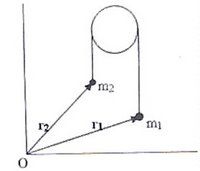A few questions on circular motion and rotation, which appeared in AIPMT 2011 question paper were discussed in the last post. A few more questions on rotational motion and centre of mass with their solution are given below. These questions were included in the All India Pre-Medical/Pre-Dental Entrance Examination (Preliminary) 2009 question paper:
(1) A thin circular ring of mass M and radius R is rotating in a horizontal plane about an axis perpendicular to its plane with a constant angular velocity ω. If two objects each of mass m be attached gently to the opposite ends of a diameter of the ring, the ring will then rotate with an angular velocity
(1) ωM /(M + 2m)
(2) ω(M + 2m) /M
(3) ωM /(M + m)
(4) ω(M – 2m) /(M + 2m)
This question is a popular one and has appeared in various entrance question papers. Its answer is based on the law of conservation of angular momentum:
I1ω1 = I2ω2 where I1 and I2 are the initial and final moments of inertia and ω1 and ω2 are the initial and final angular velocities respectively.
Therefore we have
MR2ω = (MR2 + 2 mR2) ω2
Therefore, ω2 = ωM /(M + 2m)
(2) Four identical thin rods each of mass M and length L, form a square frame. Moment of inertia of this frame about an axis through the centre of the square and perpendicular to its plane is
(1) (2/3) ML2
(2) (13/3) ML2
(3) (1/8) ML2
(4) (4/3) ML2
We have to use the theorem of parallel axes: I = ICM + Ma2 where ICM is the the moment of inertia about an axis through the centre of mass of the rod and I is the moment of inertia about a parallel axis at distance a.
The moment of inertia of a thin rod of mass M and length L about an axis through the mid point of the rod and perpendicular to its length is ML2/12. The moment of inertia of the rod about a parallel axis at a distance L/2 (which is the distance of the centre of the frame from each ro.is ML2/12 + M (L/2)2 = ML2/3
You must remember that moment of inertia is a scalar quantity. Since there are four rods in the square frame, the moment of inertia of the entire frame is four times the moment of inertia of one rod. Therefore the answer is (4/3) ML2
(3) If F is the force acting on a particle having position vector r and τ be the torque of this force about the origin, then
(1) r.τ > 0 and F.τ < 0
(2) r.τ = 0 and F.τ = 0
(3) r.τ = 0 and F.τ ≠ 0
(4) r.τ ≠ 0 and F.τ = 0
This question may appear to be a difficult one at the first glance. But this is a very simple question if you remember that the torque τ is the ‘cross product’ (vector product) of r and F:
τ = r×F
The ‘cross product’ of two vectors is a vector perpendicular to both individual vectors. The torque vector is thus perpendicular to both r and F. Therefore the ‘dot product’ (scalar product) of r and τ as well as that of F and τ is zero [Option (2)].
(4) Two bodies of mass 1 kg and 3 kg have position vectors i + 2 j + k and –3 i – 2 j + k espectively. The centre of mass of this system has a position vector
(1) –2 i – j + k
(2) 2 i – j – 2 k
(3) – i + j + k
(4) –2 i + 2 k
If two point masses m1 and m2 have position vectors r1 and r2 their centre of mass has position vector R given by
R = (m1 r1 + m2 r2) /( m1 + m2)
Here we have m1 = 1, m2 = 3, r1 = i + 2 j + k and r2 = –3 i – 2 j + k
Substituting, R = [1(i + 2 j + k) + 3(–3 i – 2 j + k)] /(1+3)
Or, R = (– 8 i – 4 j + 4 k) /4 = –2 i – j + k
You can access all questions in this section by clicking on the label ‘rotation’ below this post. Make use of the buttons ‘older posts’ and ‘newer posts’ at the end of the page to navigate through all the posts.

